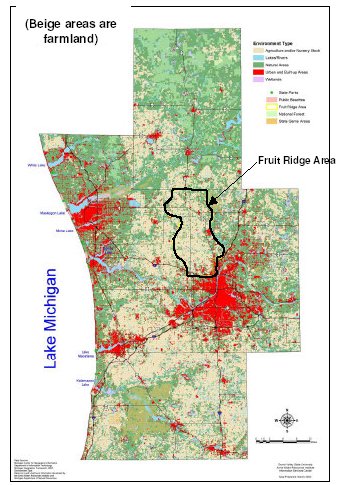Green Infrastructure - Promote Regional Farmland Preservation

Recommendation Overview
Protect Critical Biodiversity Areas
Support Development of Trails and Greenway Network
Encourage Regional Watershed and Management Planning
Protect Our Dunes and Shoreline
Promote Integration of Green Infrastructure in Urban Settings
Promote Regional Farmland Preservation
Local Implementation
Data Sharing
Next to forests, active farmland is the largest percentage of the region's current open space. Depending on the type of farm and the management practices being carried out there, working farmlands can bring many of the benefits of healthy green infrastructure and contribute to economic vitality, as well as preserve a historical way of life. Unfortunately, given the current agricultural market environment, farming just can't compete with development as a long-term economic activity, especially in areas that are already close to residential centers. Profits for agriculture are low, and prices for developable land are high. As long as this continues to be the case, we can expect to continue seeing farmland converted to developments at a rapid rate.
Our Current Farmland Assets
Farmland Facts:
- Food and agriculture is the second largest industry in the state, contributing $40 billion to the state economy each year.
- Statewide, we are losing over 80,000 acres of farmland per year to sprawl.
- West Michigan has three of the top five agricultural producing counties in the state. Ottawa County is the highest producing agricultural county in the state, with more than $300 million in agricultural sales. Kent County is the fourth highest in the state with $120 million.
- West Michigan has some of the best micro-climates in the country for growing fruits and vegetables.
- In the 15 years from 1982 to 1997 (the last agricultural census data), Kent County lost 57 square miles of farmland; Allegan lost 47 and Ottawa 20.
- Michigan has the fourth highest farmland conversion rate in the country.
- In Kent County, the value of farmland rose by 43% in the last two years, primarily reflecting development pressures, not improved farm incomes.
- In contrast to residential development, farmland provides more in taxes than it costs in services.
Recommendations:
- Support state level policy changes to promote farmland preservation.
- Support local initiatives for farmland preservation.
- Develop a long-term land use strategy for our unique Fruit Ridge area.
